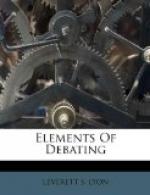THE FORENSIC
I. What the forensic is.
II. How the forensic may be developed
and delivered:
1. By writing and reading
from manuscript:
(1) Advantages and disadvantages.
2. By writing and committing
to memory:
(1) Advantages and disadvantages.
3. By oral development
from the brief:
(1) Advantages.
III. Style and gestures in the delivery
of the forensic.
When the brief is finished, the material is ready to be put into its final form. This final form is called the forensic.
As practically all debates are conducted by means of teams, the work of preparing the forensic is usually divided among the members of the team. The brief may be divided in any way, but it is desirable that each member of the team should have one complete, logical division. So it often happens that each member of the team develops one issue into its final form.
The forensic is nothing but a rounding-out of the brief. The brief is a skeleton: the forensic is that skeleton developed into a complete literary form. Into this form the oral delivery breathes the spirit of living ideas.
No better illustration of the brief expanded into the full forensic need be given than that in Exercise I, Lesson V. Compare the brief which you made of this extract from Burke with the forensic itself, a few paragraphs of which are quoted there. Any student will find that merely to glance through a part of this speech of Burke’s is an excellent lesson in brief-making and in the production of forensics. First study the skeleton only—the brief—by reading the opening sentences of each paragraph. Then see how this skeleton is built into a forensic by the splendid rhetoric of the great British statesman.[4]
There are two ways in which the forensic may be developed from the brief. Both have some advantages, varying with the conditions of the debate. One is to write out every word of the forensic. When this is done, the debater may, if he wishes, read from his manuscript to the audience. If he does so, his chances of making a marked effect are little better than if he spoke from the bottom of a well. The average audience will not follow the speaker who is occupied with raveling ideas from his paper rather than with weaving them into the minds of his hearers.
The debater who writes his forensic may, however, learn it and deliver it from memory. This method has some decided advantages. In every debate the time is limited; and by writing and rewriting the ideas can be compressed into their briefest and most definite form. Besides, the speaker may practice upon this definite forensic to determine the rapidity with which he must speak in order to finish his argument in the allotted time.




